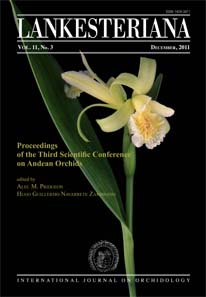Epigenetic information – Unexplored source of natural variation
DOI:
https://doi.org/10.15517/lank.v11i3.18287Keywords:
orchids, hybridization, fingerprinting analyses, epigeny, environmental influenceAbstract
Rapid progress is being made at the population-level in orchids, with a series of new molecular techniques being applied. One of the major problems observed in several groups of temperate orchids has been that ecologically distinct “taxa” do not appear to be genetically distinct. For example, we know that Dactylorhiza traunsteineri, D. majalis, and D. ebudensis are the products of hybridization between D. fuchsii and D. incarnata, but they have different ecologies and distributions within northwestern Europe. By comparing fingerprinting analyses of expressed regions to fingerprinting studies of methylation-sensitive sites in genomic DNA, we can detect patterns that indicate that some of these differences are due to changing epigenetic effects, which have been shown in several groups to be subject to environmental influence. Thus, taxa that are ecologically distinct but still appear genetically uniform may be the result of altered epigenetic controls of gene expression without any change in the underlying genetic material.
Downloads
Downloads
Published
How to Cite
Issue
Section
License
According to the Open Access policy promoted by the University of Costa Rica, all the papers published by Lankesteriana are licensed under the Creative Commons copyright and can be downloaded free of charge. The journal holds copyright and publishing rights under the CC BY-NC-ND 3.0 CR license.
Before the publication of the materials submitted by the author(s) in LANKESTERIANA, the author(s) hereby assign all rights in the article to the Lankester Botanical Garden.





